Growth and Funding Opportunities
Normal Funding State
1.In a normal State of Funding, we have one or two Legacy Systems of monotypal ubiquity upon which we become utterly vulnerable and dependent. Complexity is Low and we are Catastrophically Bound to the constraints put upon us by the Systems Policies enacted in the Echelons of Hierarchy, with which we must become compliant or risk our monopolized funding bracket.
2.Risk is over-sized with respect to Disruptors. Loss of Monolithic Legacy resources is Catastrophic.
3.Innovation and Adaptation are mostly non-existent as Policy management is mostly a one-way affair. Compliance is Mandatory. The Recipient is Programmatically Monopolized.

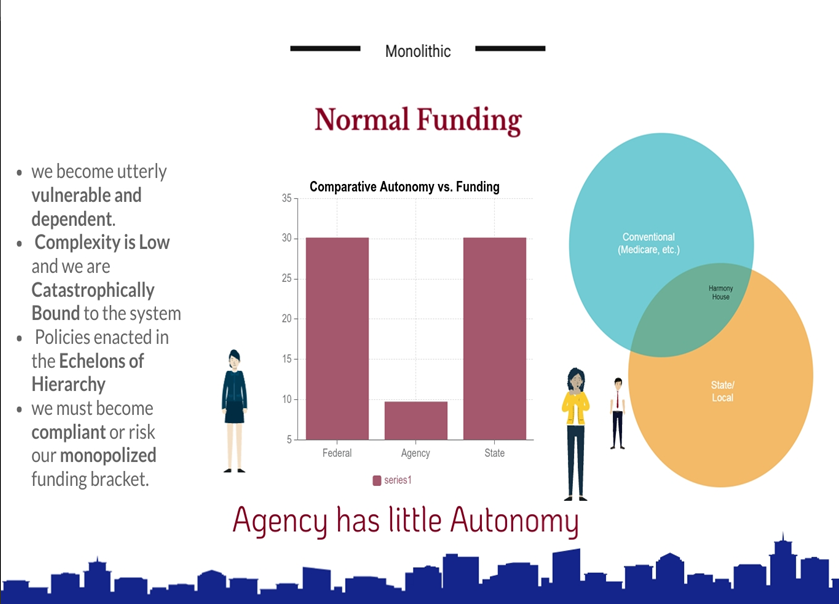
4.Any adaptation or change of course requires monumental effort to turn the ship around in the most labor intensive and inconvenient procedures imaginable. Miscalculations are devastating.
5.Consumer centered concerns become secondary to remunerative policy.
6.Here we have the example of two sources of massive legacy funding: State/Local and Federal tax dollars.
While there are notable benefits to this type of funding (stability and comprehensiveness, for example), there are inhibiting drawbacks (which are well-known and have been an issue for quite awhile). These include:
- Risk of Disruption
- Inhibition of Innovation
- Programmatic Monopolization


An analysis of Monolithic Funding shows both benefits and drawbacks, as well as what these are.
Most Agencies utilize Monolithic Legacy Funding and would be insolvent without it.
While no-one is advocating the abandonment of Comprehensive Legacy Funding, certainly a best-of-both-worlds approach would acknowledge the benefits of greater depth and diversity in funding approaches.
Divestiture, Integration & Diversity
1.Should the Winds of Political Fortune change, the Agency will suffer Catastrophic Defunding.
2.Other causes of Funding Loss (such as Pandemic Health Problems, Demographic Shift (including Age outs, etc.) not to mention miscalculations, civil unrest, or personnel scandals) are ever-present hazards which render such Monolithic Dependencies vulnerable to Chaotic Disruptors.
3.These represent un-planned-for Divestitures of Funding resources, where the Funded Areas move away from the Facility (or Agency), leaving administration in desperation and holding the bag.
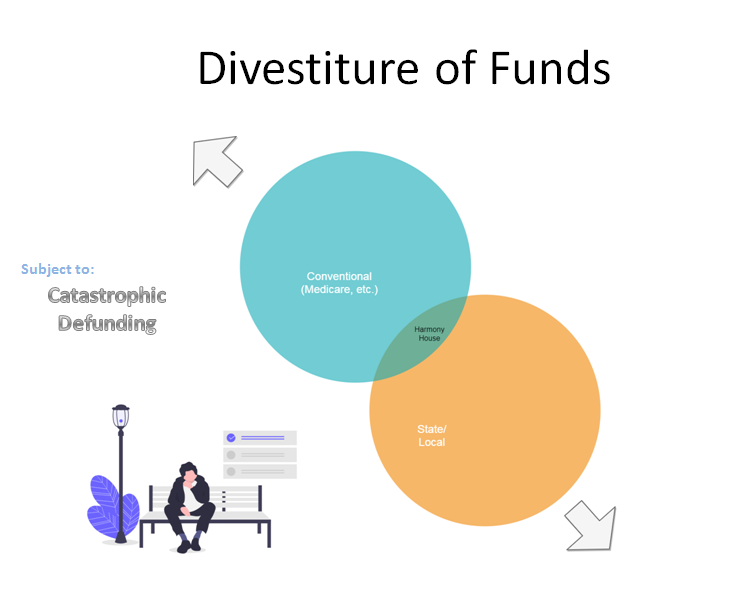

4.In this case, the Facility (or Agency) assumes fuller responsibility for direct Providership of all services to the Consumer, as the Agency becomes more and more Integrated into the Monolithic Funding sources.
Integration looks very much like the opposite of Divestiture as to the direction of the funds with respect to an Agency.
1.There are only 3 important ways to increase the funding structure of such a facility, and the first involves bringing the Circles of Funding closer into the Facility.
2.…so here we have Harmony House in the center and we are bringing the two Massive Funding Sources inward into the Facility Sphere of Influence.
3.We see that the Funding sources merge and acquire greater influence over the Facility Program, somewhat dwarfing the autonomy of the Facility.
Dis-Integration
1.Here we have 3 Major Sources of Funding (we’ve added ‘Grants’), but they are not well Integrated with each other.
2.Because of this, they often move counter to each other, decreasing their zones of commonality and causing administrative headache in the process.
3.Such cycles typically require more administrative resources to cope with every little discrepancy and the total share of Agency Funding drops accordingly, sometimes eating up any scant budgetary padding that may have been squirreled away for further projects.
4.These are counter-productive cycles that result in dis-integration and may possibly result in failure or insolvency. Typically though, they only severely cripple the agential effectiveness of the facility.
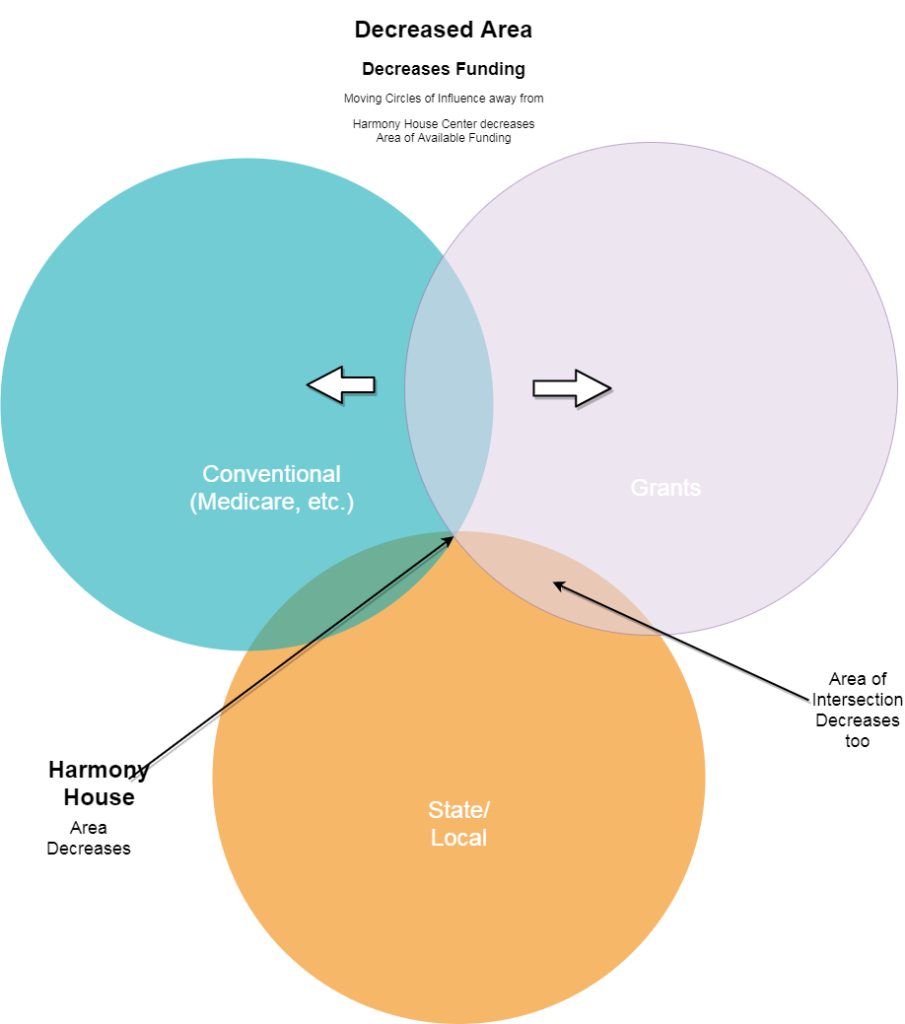
5. As the Integrative Commonality disintegrates, the Funding Decreases, and the wellbeing of the Facility diminishes as well.
Diversification

1.At the outset, we mentioned 3 general ways to increase funding resources and grow the program. So far we’ve only looked at the first way: mass integration with Monolithic sources of Legacy Funding.
2.Here we see the 2nd method of growth: Diversification. Simply put, we add more circles of influence related to funding. More funding resources equals more Funds.
3.There are two further Benefits of such a structure. First, it is less vulnerable to Catastrophic Defunding disruptions. And secondly, the zones of Cooperative Integration grow geometrically and represent further areas of Opportunity for the Agency.
4.Another benefit to the Facility is greater flexibility and autonomy with regard to draconian policy enforcements (as there are more competitive alternatives available to choose from).
5.Another observation concerns the disintegration cycle; there is less room for Monolithic Maneuvering, because any direction a Monotype moves in brings it into Integration with its competitor, thus affording the Agency an auto-limiting constraint on disintegrative forces.
6.We should note that this is Set Theory and Elements of the Sets are Represented via Perfect Round Circles. This is Idealized for ease of Comprehension, while…..
Asymmetrical Model of Funding
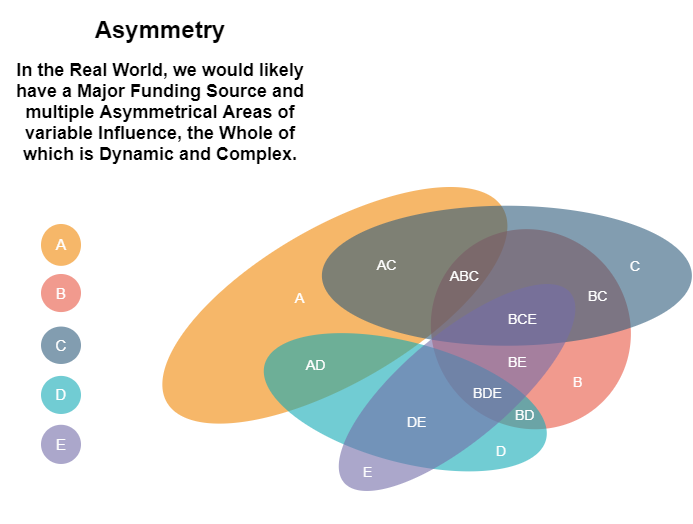
1.…in the Real World, things are not so neat and tidy. In Reality, we find a great deal of Asymmetry and not everything lines up according to script.
2.In this example, in addition to broad Asymmetry, we are introduced to a Tiered Structure. The Tiered structure is based on many different levels of operation (A, B, C, D, & E) and affords the System greater and more Robust Complexity; resulting in increased opportunity for Integration and Growth along many lines of Influence and on many levels and planes of reference.
3.In this image, many (when not all) of the member-levels are well represented in each combination of the integrated levels and Spheres of Influence.
4.We still retain one representative from the old Monolithic Legacy Fund (Coral: B), who retains her reified centrality but with increased Integration and Opportunity.
5.Interestingly, there is one Sphere that appears disjunct (Teal: D). As the model grows more Robust in Complexity, the Agency itself becomes far more fluid and mobility affords access on a Custom basis, according to Consumer needs and Agency autonomy.
Harnessing Complexity

1.As mentioned earlier, as the Agency acquires greater diversity in funding options, The old Monolithic Legacy powers have less room to deconstruct the Facility Autonomy structure and the Agency gains more Freedom and Choice.
2.Here we find multiple funding resources, fully Integrated, operating on multiple Tiered Levels, afforded very Robust Complexity.
3.This is the Picture of a Healthy Agency. Growth and Opportunity increase Geometrically as a result.
The Complex Synergistic Whole
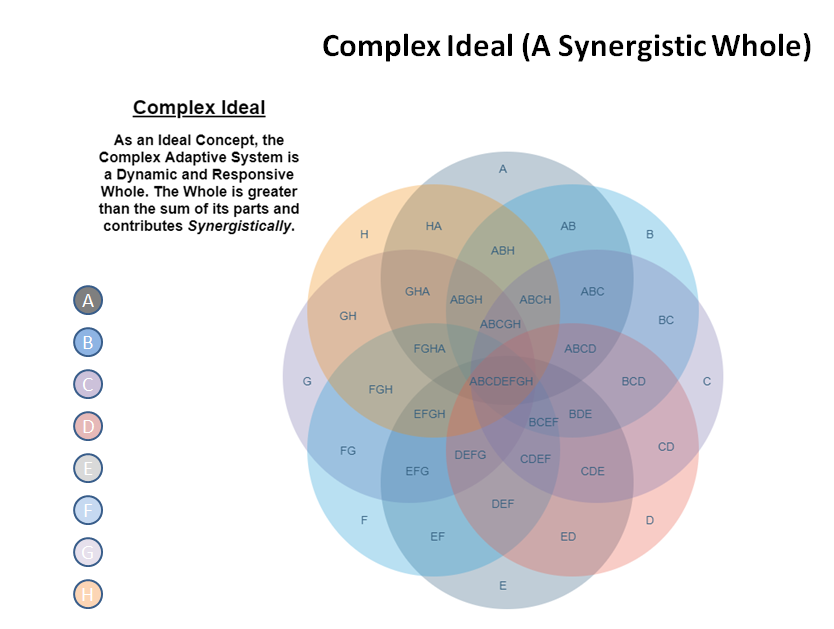
1.This image represents Maximally Synergized Complexity. We will imagine that all levels (ABCDEFG & H) are Integrated, Tier-wise, and each Sphere of Funding is Harmonically Synergized across All Quadrants & All Lines (AQAL) for Integral Idealization.
2.Such an occurrence is representative of Complex Adaptive Organizations that are Dynamic and Responsive as an Integrative Whole.
3.Once we achieve this level of Complex Integrity, we can Replicate any Sphere we so choose in infinite hypothetical iterations, infinitely without limit. Truly: no limit has been established for such a System because we are thus afforded Tiered Opportunities for Systems upon Systems, within Systems, ad infinitum. Growth and Opportunity abound with each iterated Replication (it goes Viral).
4.If we re-frame our growth opportunities in terms of Community Engagement, rather than funding sources, we arrive at a New Image of Integral Facilitation that is Generative and Social….
Complex Social Architecture
at
Harmony House

1.….which brings us at last to this Image of Harmony House vis-à-vis Community Engagement and Social Architecture.
2.Here we find Harmony House successfully Occupying the Central zone of the Integrative Influences.
3.The 4 Elements of our Tiered Community are Represented via the outer Spheres: the Business Community (Leadership & Local Economy), our Professional Community (both inter-agency and Regional Associations and CSBs), The Social Sphere (our adjacent and local Community-at-large), and foremost, our Membership Community (our Clients and Social Services Consumers).
4.The intersections of these Community Spheres are seen as vast opportunities for growth and development which benefit all participants on many levels.
5.Business and Social combine to create Employment-based growth; Business and Professional represent growth and opportunity in Conference and Networking; the Professional-Client Relationship provides Personal Growth and Development through Training and Collaboration ; while the Interactive Community and our Consumer Membership are well represented by our Event and Social Media growth and opportunity areas.
